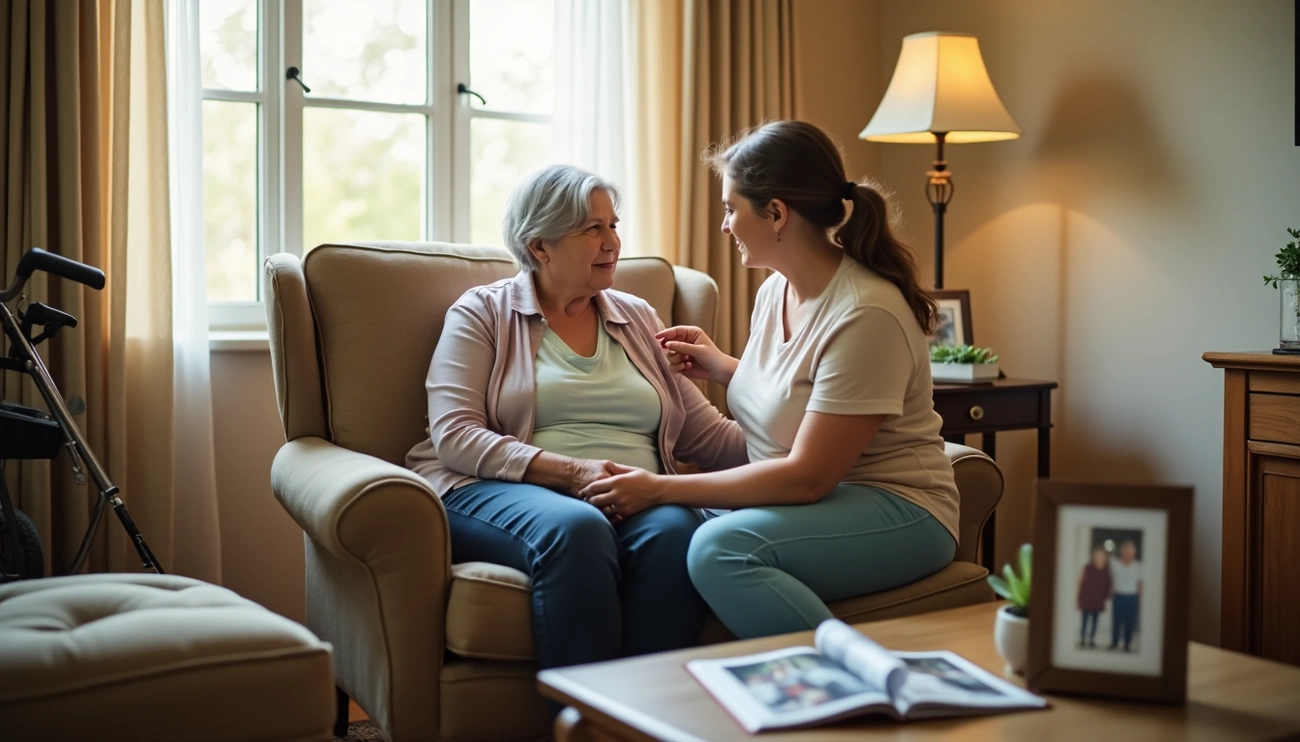One in four seniors falls each year in the United States, a statistic that often signals when to move from independent to assisted living. As our parents age, we frequently miss the subtle signs that they need more support until a crisis occurs. While more than 800,000 Americans already live in assisted living communities, recognizing the right time to make this transition remains challenging for many families.
When is it time to consider assisted living for a parent? The answer varies for each family, but certain indicators are universal. For instance, frequent falls, difficulties managing daily tasks, and increased isolation are significant signs that a senior may need assisted living care. Additionally, between 15% and 25% of seniors exhibit characteristics of hoarding disorder, creating unsafe living conditions that can worsen with age. Despite the median monthly cost of around $5,350, assisted living communities provide essential services like daily socialization opportunities and well-balanced meals that address the nutritional and social needs many seniors struggle with at home.
In this guide, we’ll explore the key signs that indicate when it’s time to move from independent living to assisted living, how to approach this sensitive conversation with your parent, and practical steps for making this important transition as smooth as possible.
Recognizing the Early Signs of Decline
Subtle changes in your parent’s physical condition often appear long before a crisis occurs. Recognizing these early warning signs can help you determine when to move from independent to assisted living for your loved one.
1. Frequent falls or mobility issues
Falls represent a serious health risk for aging adults. Every year, 3 million seniors receive emergency treatment for fall-related injuries. Watch for changes in how your parent walks—limping, dragging a foot, or walking unsteadily often indicates declining mobility. Look for bruises or other marks that might suggest they’re losing their footing. Furthermore, difficulty navigating stairs or getting in and out of cars signals that your parent may need additional support.
About one-third of 70-year-olds and most 80-year-olds report mobility restrictions even in their immediate surroundings. This limitation isn’t merely inconvenient—it’s a risk factor for injuries, hospitalizations, and diminished quality of life.
2. Missed medications or appointments
Medication management becomes increasingly challenging with age. Approximately 600,000 seniors visit emergency rooms annually due to prescription misuse. If you notice pill bottles left unopened, medications mixed together, or your parent cannot explain their medication schedule, consider these significant warning signs.
The risk for medication-related problems increases substantially when someone takes four or more medications. Consequently, if your parent takes multiple prescriptions, monitoring their medication management becomes even more crucial.
3. Changes in personal hygiene or grooming
A noticeable decline in personal appearance often signals underlying issues. Infrequent bathing, unwashed hair, or wearing the same clothes repeatedly may indicate your parent is struggling with self-care. Poor hygiene isn’t merely about appearance—it can lead to skin infections and other health complications.
Depression, diminished sensory perception, and memory issues commonly contribute to hygiene neglect. Notably, seniors may avoid bathing due to fear of falling, especially since bathtubs are a leading cause of in-home accidents.
4. Unexplained weight loss or poor nutrition
Unintentional weight loss in older adults is particularly concerning. Weight loss of 5% or more within 6-12 months is associated with increased mortality. This can result from difficulty cooking, decreased taste or smell, or underlying medical conditions.
Look for signs like empty refrigerators, expired food, or a kitchen that appears unused. Weight loss affects 15-20% of elderly people over 5-10 years, with prevalence rising to 27% in frail populations. This often reflects declining ability to shop for groceries, prepare meals, or maintain proper nutrition independently.
Emotional and Social Indicators to Watch For
Beyond physical symptoms, emotional and behavioral changes often signal when to move from independent to assisted living. These subtle shifts in your parent’s social patterns and emotional state can be equally important indicators that additional support is needed.
1. Increased isolation or withdrawal
Social withdrawal frequently precedes serious health problems in aging adults. Approximately 28% of older adults in the United States—about 13.8 million people—live alone. Although living alone doesn’t automatically mean loneliness, isolation increases risk for numerous health conditions including cognitive decline, heart disease, and depression.
Watch for a parent who suddenly stops participating in community activities or gradually reduces contact with friends. This withdrawal often happens following significant life changes—losing a spouse, retiring, or facing mobility challenges. Isolation becomes particularly concerning when it represents a change from previous social patterns rather than a lifelong preference for solitude.
2. Mood swings or signs of depression
Mood changes often signal when it’s time to consider assisted living. About 4% of adults over 70 experience depression, yet many seniors don’t seek help because they mistakenly view their symptoms as normal aging.
Rather than explicitly expressing sadness, older adults with depression typically show:
- Unexplained irritability or anger
- Complaints about physical ailments rather than emotional distress
- Feelings of worthlessness or hopelessness
- Noticeable changes in sleep patterns
These symptoms warrant professional evaluation, primarily when they last longer than two weeks.
3. Loss of interest in hobbies or social events
When a parent abandons long-enjoyed activities, this often indicates something beyond normal aging. Losing interest in hobbies—what clinicians call anhedonia—frequently accompanies depression or cognitive decline.
Notably, research shows apathy in older age could be an early sign of dementia. In one study, seniors reporting high levels of apathy showed measurably less gray and white matter in brain scans compared to engaged peers. Moreover, this disengagement creates a concerning cycle—social withdrawal leads to further cognitive decline, which increases isolation.
Initially, your parent might need help getting started with activities they once initiated independently. Subsequently, they may need assisted living’s structured social environment to maintain cognitive health and emotional well-being.
When Home Is No Longer Safe or Practical
Physical changes in the home environment often reveal when aging parents need more support. The transition from independent to assisted living becomes necessary when living spaces threaten rather than support well-being.
1. Cluttered or unsafe living conditions
The home environment speaks volumes about a senior’s ability to maintain independence. Unsanitary conditions including dirty dishes, spoiled food, accumulated trash, and neglected laundry signal declining self-care abilities. In fact, most reported cases of elder abuse involve self-neglect, often manifested through hazardous living spaces.
Look for environmental warning signs such as:
- Inadequate heating, plumbing, or ventilation
- Piles of newspapers, magazines, or mail
- Animal or insect infestations
- Human or animal waste
Hoarding affects approximately 2% of the US population and occurs significantly more often in seniors who live alone. This behavior creates dangerous obstacles and fire hazards throughout the home.
2. Difficulty managing household tasks
Activities necessary for maintaining an independent household become increasingly challenging with age. Nearly 70% of difficulties reported by independently living older adults relate to cleaning or outdoor maintenance. Furthermore, 34% of people over 75 report great difficulty with at least one household activity.
Household tasks typically presenting challenges include:
- Vacuuming and mopping (seniors fear falling on wet floors)
- Laundry (lifting heavy baskets becomes difficult)
- Reaching high shelves
- HVAC maintenance and basic home upkeep
3. Becoming a danger to oneself or others
Self-neglect occurs when an older adult becomes “unwilling or unable to do needed self-care”. The U.S. Consumer Products Safety Commission estimates approximately 2.9 million people 65 or older require hospital treatment yearly due to in-home injuries.
Concerning behaviors include leaving cooking appliances on, confusion about medications, or frequent falls. Outdated food in refrigerators, unpaid bills, or missed appointments likewise indicate declining capacity. Ultimately, when daily living problems arise from cognitive impairment, supervision becomes essential to ensure safety.
Planning the Transition to Assisted Living
Making a meaningful assisted living transition requires planning, patience, and preparation. Once you’ve recognized the signs that your parent needs more support, taking proactive steps can transform this challenging process into a positive new chapter.
1. When to consider assisted living
According to health professionals, the ideal time to consider assisted living is before a crisis forces your hand. Waiting for an emergency like a serious fall or health scare often leads to rushed decisions. Ultimately, the right time arrives when safety concerns outweigh independence benefits.
Common tipping points include:
- Inability to manage medications or daily tasks
- Frequent falls or mobility challenges
- Caregiver burnout when family members can no longer provide adequate support
- Social isolation that impacts mental health
2. How to talk to your parent about the move
Start conversations early and approach the topic with compassion. In most cases, you’ll need multiple discussions rather than expecting immediate agreement. Choose a quiet setting for these conversations, and importantly, listen to your parent’s concerns without judgment.
First of all, connect the benefits of assisted living to values your parent holds dear—whether that’s independence, social interaction, or safety. Frame the conversation around enhancing quality of life rather than focusing on limitations. Remember that for many seniors, this discussion represents a significant loss of autonomy, hence approaching it with empathy is essential.
3. Choosing the right facility
Research thoroughly and visit multiple communities before making a decision. During tours, observe:
- Staff interactions with residents
- Cleanliness and overall environment
- Available amenities and activities
- Safety features and protocols
Ask specific questions about staff qualifications, emergency procedures, and care options. After visiting, trust your intuition about which community feels right for your parent’s personality and needs.
4. Preparing emotionally and logistically
Emotionally, acknowledge that adjustment typically takes three to six months. Both you and your parent may experience guilt, sadness, or anxiety during this transition. Involving your parent in personalizing their new space with familiar items can ease this adjustment.
Logistically, create a detailed moving checklist addressing:
- Downsizing possessions thoughtfully
- Completing required paperwork and legal matters
- Setting up utilities and mail forwarding
- Coordinating with healthcare providers
As a result, with careful planning and emotional support, the transition to assisted living can become a positive step toward improved quality of life.
Conclusion
Transitioning a parent to assisted living undoubtedly represents one of the most challenging decisions families face. Throughout this guide, we’ve explored the critical signs that indicate when additional support becomes necessary – from physical decline and emotional changes to unsafe living conditions that compromise well-being.
Making this move before a crisis occurs offers significant advantages. Accordingly, recognizing early warning signs like medication confusion, mobility issues, or social withdrawal empowers families to approach this transition thoughtfully rather than reactively. The right assisted living community addresses not just safety concerns but also provides crucial social engagement and nutritional support that many seniors lack at home.
Above all, remember this transition involves both practical considerations and emotional adjustments. While statistics and warning signs provide helpful guidelines, each family’s journey remains unique. Taking time to visit multiple communities, involving your parent in decisions, and approaching conversations with empathy creates the foundation for a successful transition.
Although this process may initially feel overwhelming, breaking it down into manageable steps makes it more approachable. Starting with honest conversations, researching communities thoroughly, and planning the logistics mindfully transforms what might seem like an ending into a new beginning – one that prioritizes your parent’s dignity, safety, and quality of life.
Finally, patience proves essential during this adjustment period. With thoughtful preparation and ongoing support, assisted living can provide your parent with the perfect balance of independence and assistance they need to thrive in this next chapter.
FAQs
Q1. What are the key signs that an elderly parent needs assisted living? Key signs include frequent falls, difficulty managing medications, changes in personal hygiene, unexplained weight loss, increased isolation, and unsafe living conditions. If you notice multiple of these signs, it may be time to consider assisted living care for your parent.
Q2. How do I approach the conversation about moving to assisted living with my parent? Start the conversation early, before a crisis occurs. Choose a quiet setting and approach the topic with empathy. Focus on how assisted living can enhance their quality of life rather than limitations. Be prepared for multiple discussions and listen to your parent’s concerns without judgment.
Q3. What should I look for when choosing an assisted living facility? When selecting a facility, observe staff interactions with residents, cleanliness, available amenities, and safety features. Ask about staff qualifications, emergency procedures, and care options. Visit multiple communities and trust your intuition about which one feels right for your parent’s personality and needs.
Q4. How long does it typically take for a senior to adjust to assisted living? The adjustment period for seniors moving to assisted living typically takes three to six months. During this time, both you and your parent may experience a range of emotions. Involving your parent in personalizing their new space and providing emotional support can help ease this transition.
Q5. What if my parent refuses to consider assisted living despite clear need? If your parent adamantly refuses assisted living despite clear signs of need, consider seeking professional help. Consult an elder care lawyer or a geriatric social worker who can provide advice and potentially mediate the situation. In extreme cases, they may advise on seeking guardianship to ensure your parent’s safety and well-being.












